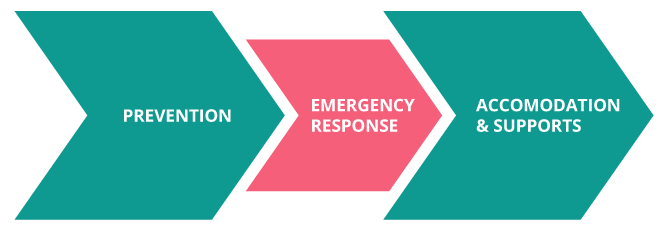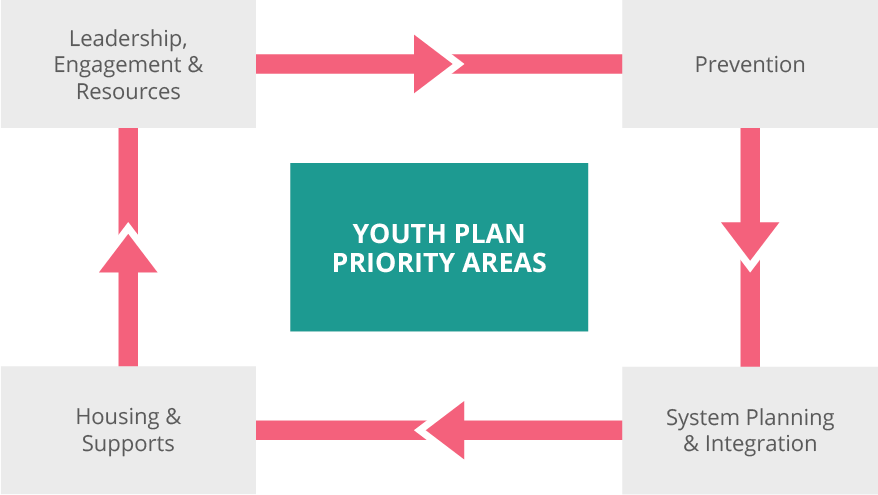What does it take to end youth homelessness? The answer to this question should shape the main tenets of your plan and how you go about developing it. While there are a wide range of options, there are common elements that should be included in your plan, whether you’re a small rural community or large urban centre; whether Indigenous youth or LGBTQ2S youth are overrepresented, etc.
If your community believes the answer is to develop more emergency services, such as shelters, or that the homeless-serving system can do it independently without changes to the operation of the wider public systems, your plan will be incomplete, which will lead to gaps in implementation and hinder your efforts to end youth homelessness.
The Reimagining our Response report contains a commonly used strategic framework for developing and implementing plans to end youth homelessness. Edmonton, Kamloops and St. John’s specifically cite this report as grounding to their youth plans.
Gaetz proposes the following steps towards ending youth homelessness:
- Develop a plan;
- Create an integrated system response;
- Facilitate active, strategic and coordinated engagement by all levels of government and interdepartmental collaboration;
- Adopt a youth development orientation; and
- Incorporate research, data gathering and information sharing.
Gaetz’s framework, a reorientation of the current response, involves three key approaches: a strong emphasis on prevention and strategies that move people quickly out of homelessness into appropriate accommodation with supports, reinforced by emergency services.
Figure 2: Prevention-focused Approach

To operationalize a prevention-focused approach, your youth plan must cover the four Youth Plan Priorities. These four elements are synthesized from the existing body of evidence and are commonly found in existing plans. While you should adapt these locally, according to your community’s priorities and needs, the general approach should remain consistent across communities.
Figure 3: Youth Plan Priority Areas

Prevention can include measures that specifically target youth at risk of homelessness, through such programs as family mediation/reunification, working with the education system to identify those at risk earlier and developing policy options that can ensure youth are better supported in transitioning from foster care. The focus here is working upstream to identify those at risk of homelessness and putting in place interventions that effectively mitigate such risks.
System planning and integration refers to the type of reorganization actions you will need to introduce to ensure your local system serves youth effectively and efficiently. This includes introducing ways of managing the flow of clients better through coordinated entry, having consistent performance management and quality assurance standards in place, but also developing processes to link the youth-serving system to the public systems as well. Discharge protocols for youth coming out of treatment or finding ways to coordinate services between diverse systems can be included in this priority area.
Housing and supports refers to the network of services and accommodation options necessary to end homelessness for youth; diverse and appropriate housing and supports (case management, income assistance, education, health care, etc.) ensure that once rehoused, youth do not fall back into homelessness. To achieve this, you may need to expand particular program types or introduce new program models and housing stock. You may also need to rethink how services are delivered in practice. The way your emergency shelters and transitional housing program operate can also be re-envisioned to move youth into permanent housing quicker, for instance. The Housing First Framework for Youth provides guidance on housing options and supports designed to meet the needs of young people in a way that supports not only housing retention but also a supportive transition to adulthood.
Leadership, engagement and resources are needed to execute the vision set out in the plan. This includes funding, organizational infrastructure, champions to promote the solutions to diverse audiences and shared accountability among stakeholders for ending youth homelessness. Additionally, you may include public education measures to raise awareness about preventing and ending youth homelessness. You may also plan for a research agenda to enhance knowledge about the issue and advance a policy agenda to various levels of government.
Table 4: Priority Areas Resources
